
Carpenter bees are species in the genus Xylocopa of the subfamily Xylocopinae. The genus includes some 500 bees in 31 subgenera. The common name "carpenter bee" derives from their nesting behavior; nearly all species burrow into hard plant material such as dead wood or bamboo. The main exceptions are species in the subgenus Proxylocopa, which dig nesting tunnels in suitable soil.

Bee pollen, also known as bee bread and ambrosia, is a ball or pellet of field-gathered flower pollen packed by worker honeybees, and used as the primary food source for the hive. It consists of simple sugars, protein, minerals and vitamins, fatty acids, and a small percentage of other components. Bee pollen is stored in brood cells, mixed with saliva, and sealed with a drop of honey. Bee pollen is harvested as food for humans and marketed as having various, but yet unproven, health benefits.

Xylocopa virginica, sometimes referred to as the eastern carpenter bee, extends through the eastern United States and into Canada. They are sympatric with Xylocopa micans in much of southeastern United States. They nest in various types of wood and eat pollen and nectar. In X. virginica, dominant females do not focus solely on egg-laying, as in other bee species considered to have "queens". Instead, dominant X. virginica females are responsible for a full gamut of activities including reproduction, foraging, and nest construction, whereas subordinate bees may engage in little activity outside of guarding the nest.

Xylocopa violacea, the violet carpenter bee, is the common European species of carpenter bee, and one of the largest bees in Europe. It is also native to Asia.
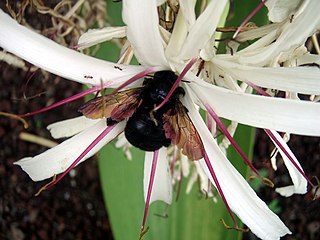
Xylocopa sonorina, the valley carpenter bee or Hawaiian carpenter bee, is a species of carpenter bee found from western Texas to northern California, and the eastern Pacific islands. Females are black while males are golden-brown with green eyes.

The California carpenter bee or Western carpenter bee, Xylocopa californica, is a species of carpenter bee in the order Hymenoptera, and it is native to western North America.

Xylocopa valga is a species of carpenter bee common to: western, central and southern Europe, except for far northern latitudes; the Caucasus; Middle East; Central Asia; and Mongolia. The species has become extinct in Latvia and Lithuania.
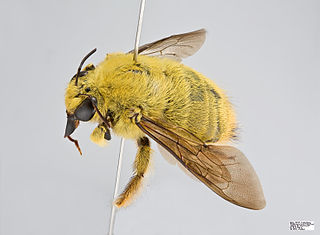
Xylocopa caffra is a species of Afrotropical carpenter bee that ranges from west to central and southern Africa, besides Madagascar and some Indian Ocean archipelagos.

Xylocopa aestuans, or Xylocopa (Koptortosoma) aestuans, is a species of carpenter bee. It is widely distributed in Southeast Asia.

Xylocopa auripennis, or Xylocopa (Biluna) auripennis, is a species of carpenter bee. It is widely distributed in South Asian countries, and Southeast Asian countries.
Xylocopa tranquebarica, or Xylocopa (Nyctomelitta) tranquibarica, is a species of carpenter bee. It is found only in South Asian and Southeast Asian countries. It is a nocturnal bee.
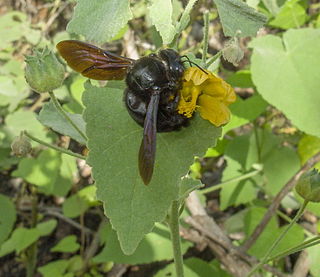
Xylocopa darwini, the Galápagos carpenter bee, is the only native species of bee in the Galápagos Islands, to which it is endemic. Altogether, only three species of bee are found in the islands. This species is found on 75% of the largest islands. It is sexually dimorphic and is known for its complex behavior. As the only native bee, Xylocopa darwini serves as an important primary pollinator within the plant-pollinator network of the archipelago.
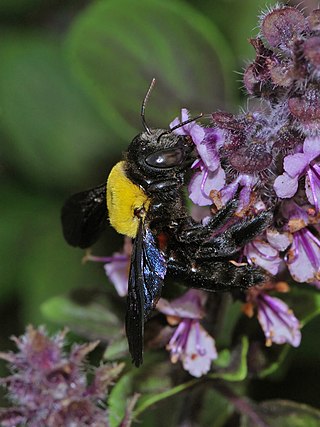
Xylocopa pubescens is a species of large carpenter bee. Females form nests by excavation with their mandibles, often in dead or soft wood. X. pubescens is commonly found in areas extending from India to Northeast and West Africa. It must reside in these warm climates because it requires a minimum ambient temperature of 18 °C (64 °F) in order to forage.

Xylocopa micans, also known as the southern carpenter bee, is a species of bee within Xylocopa, the genus of carpenter bees. The southern carpenter bee can be found mainly in the coastal and gulf regions of the southeastern United States, as well as Mexico and Guatemala. Like all Xylocopa bees, X. micans bees excavate nests in woody plant material. However, unlike its sympatric species Xylocopa virginica, X. micans has not been found to construct nest galleries in structural timbers of building, making it less of an economic nuisance to humans. Carpenter bees have a wide range of mating strategies between different species. The southern carpenter bee exhibits a polymorphic mating strategy, with its preferred method of mating changing as the season progresses from early spring to mid summer. Like most bees in its genus, the southern carpenter bee is considered a solitary bee because it does not live in colonies.

Xylocopa appendiculata is a species of carpenter bee in the family Apidae. It originates from eastern Asia and was first found in the United States in 2013.

Xylocopa mexicanorum is a species of carpenter bee in the family Apidae. It is found in Central America and North America.
Xylocopa micheneri is a species of carpenter bee in the family Apidae. It is found in Central America and North America.

Ophyiulus is a genus of millipedes in the family Julidae. There are more than 30 described species in Ophyiulus.
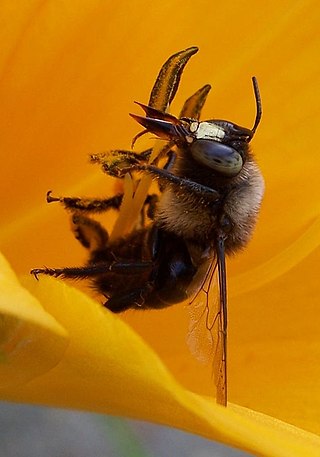
Xylocopa tabaniformis, the horsefly-like carpenter bee or mountain carpenter bee is a species of carpenter bee in the family Apidae. It is found in Central America, North America, and South America. It is 12–18 millimetres long and black. Males have yellow hair on the thorax.















